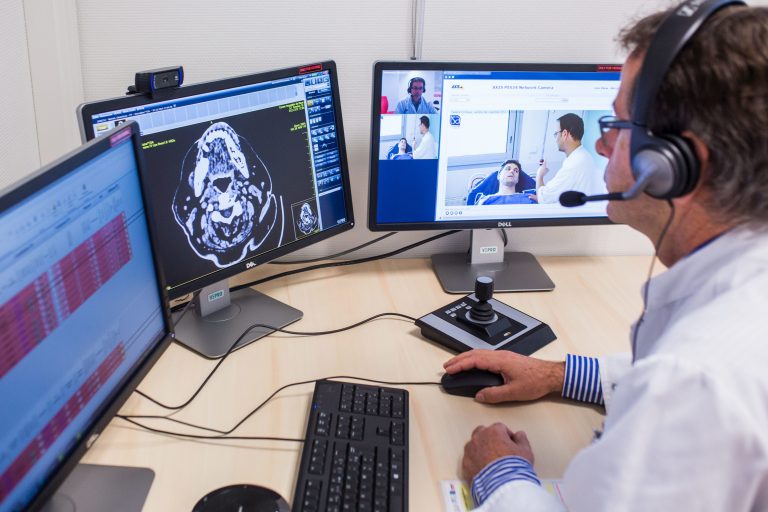Communication in a remote team. How to create the information structure of a distributed organization?
How to build and develop a culture of remote work based on effective communication?
“Corporate communication plays a key role in the day-to-day management of an organization” – this sentence has been said many times. After all, it is mainly on the quality of internal communication that other aspects depend, e.g. employee motivation, team efficiency, the level of tasks performed, process improvement, shaping employee attitudes, adaptation to changes and many, many more
In short – proper communication affects the overall functioning of an organization, its competitiveness and better business results. To what extent does good communication also translate to organizations operating remotely?
Communication in a remote team is the unconditional foundation on which to build mature, strong organizations based on a remote work culture . In fact, it is quite a challenge – remote communication is often reduced to the resulting task accounting.
However, it is more difficult and requires mindfulness – it is much easier to communicate “in real life” when you can talk face to face, explain, explain, observe the reaction and body language. Employee management and remote communication with the team oblige to double effort and exposes all communication shortages of the company.
Despite the fact that we communicate in various organizations, on many levels, directly and virtually, the common denominator of all communication are – so often underestimated or overlooked in online work – trust and interpersonal relationships. How to take care of them?
- Trust should be based on clear communication of goals and mutual expectations. It is also known as “playing cards” or “calling a spade a spade”. Openness in speaking both about what went wrong and about mistakes. Building the team’s trust requires the leader to create space for asking questions, free discussion, submitting ideas, comments and suggestions. The most important thing in communication is transparency.
- Interpersonal ties – these are good relationships that affect internal motivation and willingness to work. They build the unique atmosphere of each team. Positive relationships correspond to the need to belong, and on their basis harmonious teams are formed. It is important for the leader to ensure team integration, which can be particularly difficult in virtual space. The so-called small talk during online meetings asking “what’s up” in the team. It is also a good idea to organize non-binding activities during breaks at work (e.g. meetings in the kitchen will be replaced by shared coffee remotely, the team celebrates small and large holidays together, meets at thematic calls, virtual games, etc.). Building a team in which people know and feel comfortable is conditioned by systematic communication .
The universal foundations are described above, on the basis of which, by selecting the appropriate tools adequate in a given situation, we can “build” effective communication in a remote team . Adapting the right content and tools depends on the goal, intention and level of communication.
Company-wide communication
Company-wide communication enables the effective flow of information at all levels of the organization. It is extremely important because it usually concerns “high-level” matters – strategic, company-wide, structural, etc. All employees of the company should know what is happening in the organization. In this case, there is no room for selective provision of information and understatement. Company-wide communication should be thoughtful, prioritized, and anticipated of rumors. The commitment and consistency of the management team are fundamental – before a message is sent to employees, you should be sure that the managerial division speaks with one voice.
The consequences of the lack of or poorly conducted corporate communication are serious: gossip and writing black scenarios instead of understatements, disturbed sense of security of employees, uncertainty, decreased involvement, and sometimes even layoffs. In remote organizations, systematic virtual meetings work well in the form of the so-called town hall meetings , i.e. summaries of the quarter, indicating the direction of the company’s activity and goals for the coming months, discussing the successes, failures and changes concerning the organization at the global level.
Apart from the tools for online conferences, the ongoing exchange of information can be supported via an intranet, internal blog, video, application or e-mail. Each of these tools has its own character and the combination of several of them will allow you to build the entire information architecture. In this way, not only will all messages be easier to convey, but also archived and retrieved.
The most common errors in this area include:
- complete lack of company-wide communication – because if it is a remote organization, why would it?
- lack of involvement of management,
- inconsistency of messages coming “from the top” of the organization,
- provision of selective information,
- transmission of strategic information “after the fact”,
- “coloring” reality in place of reliable, authentic data,
- irregularity of messages.
Team communication
Usually applies to specific project groups, departments, individual divisions in the organization. In remote teams, it is often limited to cooperation for a specific purpose, planning, monitoring and accounting for tasks. However, the leader should make sure that all team members first know the answer to the following questions: why are we doing this? What results can we achieve together? How will our activities translate into the development of the organization? It is important to maintain two-way communication , invite people to create various ideas and solutions to problems.
Next, we should deal with the ordering, division and way of carrying out tasks – clear assignment of responsibilities, setting deadlines for their completion, etc. It is worth ensuring a clearly communicated goal and agenda of online meetings, selection of participants (only people interested in a given issue), cyclical summaries of work progress and an action plan for the next days / weeks.
You should also bear in mind the nature of the group (dominant vs. more shy people) and ask questions by name, and encourage meeting participants to turn on their cameras. Tools supporting this type of communication include: online conferences or teleconferences, project management programs / platforms, dedicated team channels in corporate messengers, intranet .
Common errors in remote team communication:
- lack of preparation of the leader (agenda, purpose of the meeting),
- unproductive meetings that do not result in anything,
- too long online meetings that result in loss of concentration,
- lack of space for asking questions – one-way communication,
- defensive meeting – verbal scuffles between participants, due to which the idea of the meeting escapes,
- lack of care for relations, team integration,
- “military” accounting of the project stages / work progress.

Individual communication
Individual communication consists of single interactions with co-workers that build a bond between the employee and the supervisor. Each leader should be aware of the individual needs of his team members. Especially when it is much more difficult to notice the signs of emerging problems among people working remotely. This type of communication requires an appropriate matching of the message to the personality and the temperament of a particular person. A tool that will make it easier to understand the differences in communication between our colleagues is, for example, the DISC personality model. It may also be helpful to choose the appropriate management style depending on the degree of advancement of the employee in the organization and performed duties. A solid basis is, for example, Situational Management according to Blanchard.
We must be aware that providing feedback, getting to know the needs of employees, monitoring their commitment and achieving individual goals online may turn out to be a difficult task. However, it should be remembered that instead of written communication, a conversation via a voice or video connection will be much better.
In the area of individual communication, the leader’s mistake is:
- communicating with the employee only in writing, e.g. by e-mail or messaging,
- establishing contact only when we want to provide critical comments or have an “interest”,
- mismatch of the message to the interlocutor,
- mismatch of the management style to the employee’s development stage,
- lack of care for the relationship with the subordinate; complete lack of contact,
- being unavailable, not replying to messages, ignoring voice calls.
An inherent element of remote work is to define communication rules and standardize tools along with determining for what purposes they should be used. Their selection should depend on what we want to achieve and convey.
For example, in order to communicate information without interaction, an e-mail or message on an intranet or official company messenger may be sufficient. However, a voice or video connection will be better for providing feedback, motivating, working out a solution to a problem or maintaining a relationship.
The most frequently used remote communication tools in companies
- videoconferencing programs (e.g. Skype, Ms Teams, Zoom, Hangouts),
- e-mails ,
- internal intranet,
- business phones,
- corporate social networking sites (e.g. Slack, Yammer, Emplo, Workplace),
- newsletter,
- company blog.
Nowadays, when more and more companies decide to switch to remote work mode, and the workplace becomes a more virtual than physical space, creating mature organizations and committed teams is of particular importance. An inseparable element of building a work environment that employees will not want to leave quickly is company communication – considered at the global, team and individual level. Professional communication, the core of which is trust and interpersonal relationships. Systematic, honest, transparent, engaging, anticipating rumors, comprehensive – one that does not appear selectively.
Moving in the virtual space, shaping appropriate communication activities seems to be quite a challenge, requiring thoughtful steps, appropriate tools and a lot of effort. Fortunately, you can find numerous tools supporting remote work on the market, choose the most appropriate ones and adapt them to the specifics of a given organization. We hope that the above post has cleared all your doubts about how to develop a culture of remote work.







